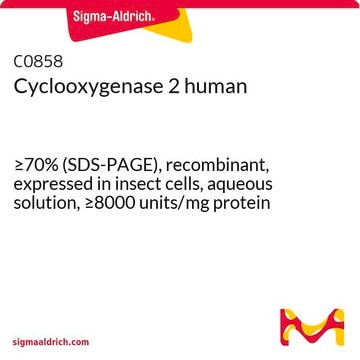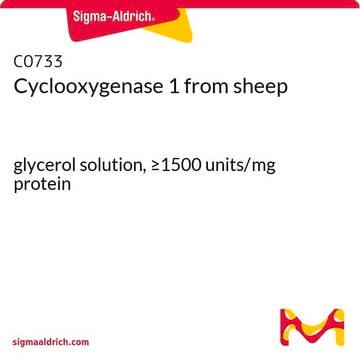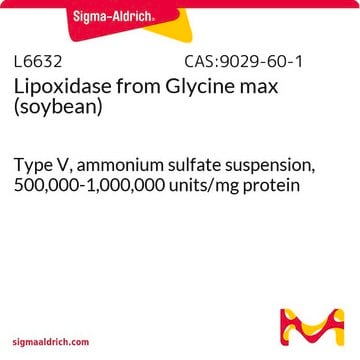437996
5-Lipoxygenase, Human, Recombinant, S. fruigiperda
5-Lipoxygenase, Human, Recombinant, S. frugiperda E.C 1.13.11.34, catalyzes the formation of 5(S)-HpETE from arachidonic acid and its subsequent conversion to leukotriene A4.
Synonym(s):
5-LO
Sign Into View Organizational & Contract Pricing
All Photos(1)
About This Item
Recommended Products
Quality Level
form
liquid
specific activity
~20 U/mg
manufacturer/tradename
Calbiochem®
storage condition
OK to freeze
avoid repeated freeze/thaw cycles
shipped in
wet ice
storage temp.
−70°C
General description
Recombinant, human 5-Lipoxygenase expressed in S. fruigiperda insect cells using a baculovirus overexpression system. 5-LO catalyzes the formation of 5(S)-HpETE from arachidonic acid and its subsequent conversion to leukotriene A4. It is localized in the cytosol of resting human and rat peripheral blood neutrophils, whereas it is found in the nucleus in rat basophilic leukemia cells and human alveolar macrophages. Upon stimulation of the cell, 5-LO translocates to the nuclear membrane where it is found in association with 5-LO activating protein (FLAP) and with the 85 kDa cPLA2.
Recombinant, human 5-Lipoxygenase expressed in S. fruigiperda insect cells using a baculovirus overexpression system. It is localized in the cytosol of resting neutrophils, and is found in the nucleus in rat basophilic leukemia cells and human alveolar macrophages. Upon stimulation of the cell, 5-LO translocates to the nuclear membrane where it is found in association with 5-LO activating protein (FLAP) and with the 85 kDa cPLA2.
Warning
Toxicity: Standard Handling (A)
Unit Definition
One unit is defined as the amount of enzyme that consumes 1.0 nmol of oxygen per min at 25°C in 50 mM Tris-HCl, 100 µM arachidonate, 2 mM CaCl₂, 1 mM ATP, 250 µM oxygen. Oxygen consumption can be measured using a oxygraph equipped with a Clark oxygen electrode.
Physical form
In 100 mM Tris containing 5 mM EGTA, pH 8.0.
Reconstitution
Following initial thaw, aliquot and freeze (-70°C).
Other Notes
Brock, T.G., et al. 1997. J. Biol. Chem.272, 8276.
Pouliot, M., et al. 1996. Eur. J. Biochem.238, 250.
Zhang, Y.Y., et al. 1993. J. Biol. Chem.268, 2535.
Shimizu, T., et al. 1984. Proc. Natl. Acad. Sci. USA81, 689.
Pouliot, M., et al. 1996. Eur. J. Biochem.238, 250.
Zhang, Y.Y., et al. 1993. J. Biol. Chem.268, 2535.
Shimizu, T., et al. 1984. Proc. Natl. Acad. Sci. USA81, 689.
Legal Information
CALBIOCHEM is a registered trademark of Merck KGaA, Darmstadt, Germany
Storage Class Code
10 - Combustible liquids
WGK
WGK 1
Flash Point(F)
Not applicable
Flash Point(C)
Not applicable
Certificates of Analysis (COA)
Search for Certificates of Analysis (COA) by entering the products Lot/Batch Number. Lot and Batch Numbers can be found on a product’s label following the words ‘Lot’ or ‘Batch’.
Already Own This Product?
Find documentation for the products that you have recently purchased in the Document Library.
Customers Also Viewed
Ha Thi Nguyen et al.
Scientific reports, 10(1), 15965-15965 (2020-10-01)
Natural metabolites with their specific bioactivities are being considered as a potential source of materials for pharmacological studies. In this study, we successfully isolated and identified five known clerodane diterpenes, namely 16-oxo-cleroda-3,13(14)E-dien-15-oic acid (1), 16-hydroxy-cleroda-3,13-dien-15-oic acid (2), 16-hydroxy-cleroda-4(18),13-dien-16,15-olide (3), 3α,16α-dihydroxy-cleroda-4(18),13(14)Z-dien-15,16-olide
Mater H Mahnashi et al.
Evidence-based complementary and alternative medicine : eCAM, 2022, 7921408-7921408 (2022-04-12)
Background. The current study aims to give a scientific origin for employing Habenaria plantaginea Lindl. as a potential candidate against nociception, inflammation, and pyrexia. The pharmacological studies were performed on crude extract and subfractions. In the gas chromatography-mass spectroscopy analysis
Our team of scientists has experience in all areas of research including Life Science, Material Science, Chemical Synthesis, Chromatography, Analytical and many others.
Contact Technical Service









